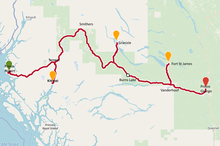Highway of Tears | |
|---|---|
 Highway of Tears corridor including some paved egresses from outlying communities to Highway 16. | |
| Details | |
| Victims | 80+ |
Span of crimes | 1970–present |
| Country | Canada |
| Location(s) | Prince George, British Columbia Prince Rupert, British Columbia |
The Highway of Tears is a 719-kilometre (447 mi) corridor of Highway 16 between Prince George and Prince Rupert in British Columbia, Canada, which has been the location of crimes against many women, beginning in 1970 when the highway was completed. The phrase was coined during a vigil held in Terrace, British Columbia in 1998, by Florence Naziel, who was thinking of the victims' families crying over their loved ones.[1] There are a disproportionately high number of Indigenous women on the list of victims, hence the association with the Missing and Murdered Indigenous Women (MMIW) movement.
| External videos | |
|---|---|
Proposed explanations for the years-long endurance of the crimes and the limited progress in identifying culprits include poverty, drug abuse, widespread domestic violence, disconnection with traditional culture and disruption of the family unit through the foster care system and Canadian Indian residential school system.[2][3][4][5] Poverty in particular leads to low rates of vehicle ownership and mobility; thus, hitchhiking is often the only way for many to travel vast distances to see family or go to work, school, or seek medical treatment. The lack of public transportation between communities was at one time a major factor. Another factor leading to unsolved disappearances is that the area is largely isolated and remote. Soft soil in many areas makes burial easier and carnivorous scavengers often carry away human remains.[6][7][8]
- ^ "Murdered and missing native women remain unsolved mysteries". Terrace Standard. 30 September 1998.
- ^ a b Lee, Miyoung (17 November 2009). "BC's infamous 'Highway of Tears'". CBC Digital Archives. Canadian Broadcasting Corporation. Retrieved 10 December 2009.
- ^ "Highway of Vanishing Women", Daily Beast, 10 July 2011
- ^ Tallman, Rebecca A. (2014). Representations of security and insecurity in the Highway of Tears (MA thesis). University of Northern British Columbia. OCLC 1330564799.
- ^ "The Taken: Who qualifies as a serial killer and more on the data behind the project". Retrieved 5 February 2019.
- ^ Lovegrove, Donald (23 February 2013). "Northern BC & Haida Gwaii". British Columbia Travel and Adventure Vacations. Retrieved 2 February 2019.
- ^ Cite error: The named reference
:28was invoked but never defined (see the help page). - ^ "Soils of the Prince George, McLeod Lake area – MOE Technical Document 29" (PDF). Ministry of Environment.